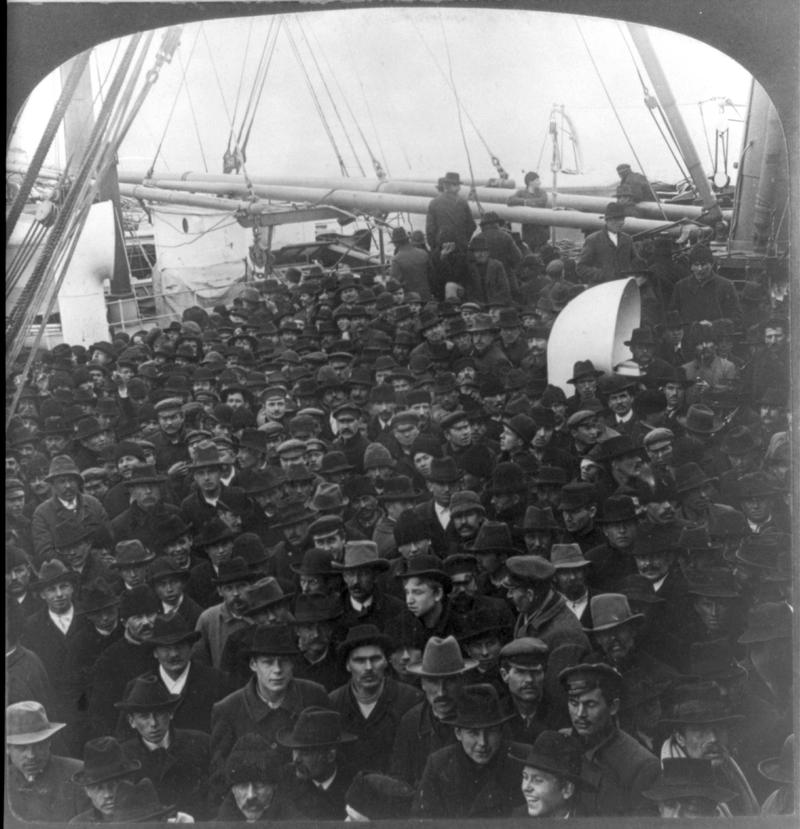 The NYPR Archive Collections
The NYPR Archive Collections
Episode 15 Slavs in the United States Part II

From the Office of Education study guide:
THE SLAVS: POLES, CZECHS, AND SLOVAKS
Only by means of their humble but indispensable qualities, because of their sweat and titanic work, could this country achieve such an unprecedented level of prosperity and might:—THADDEUS HOINKE.
THE POLES, THE EARLY POLES.
Among those who settled with John Smith in Jamestown, Virginia, in 1607, were a few Poles skilled in the art of making pitch, tar, and soap ashes. These men protested vigorously when they were not allowed to vote in the Virginia House of Burgesses. The dispute is recorded in the Court Book of the Virginia Company of London (July 13, 1619): "Upon some dispute of the Polonians resident in Virginia, it was now agreed that they shall be enfranchised and made as free as any inhabitant there whatsoever." - A few years later, the Poles settled in New Amsterdam. They became farmers and helped the Netherlanders in their war with the English. They also settled with the Swedes along the Delaware, with William Penn in Pennsylvania, and in small numbers in each of the Colonies. In 1735, John Anthony Sadowsky founded a trading post where Sandusky, Ohio now stands. Famous Soldiers. An outstanding Pole who took part in the War of Independence was Thaddeus Kosciuszko. He was an officer in the army of George Washington and helped to build West Point. Another famous Polish soldier in Washington's army was General Casimir Pulaski, who lost his life at the Siege of Savannah. It was about this time that Poland was divided among Russia, Germany, and Austria.
After unsuccessful revolts in 1830, 1848, and 1863, many Polish exiles sought refuge in the United States. By 1865, the Poles had settled in every state in the Union, particularly in New York, Wisconsin, Michigan, California, Texas, and Illinois. What They Did. Like the other Slavs, the Poles came in large numbers from 1870 up to the opening of the World War. At first, they settled in the industrial cities, although many moved on to the farms of Wisconsin and the Dakotas. The Poles came in greatest numbers after the Russian Revolt of 1905. They went to work in our coal mines and steel mills. In New England, they took abandoned farms and made the Connecticut River Valley blossom. The Poles have had a great influence on our music, art, agriculture, industry, engineering, and medicine.
THE CZECHS, AND SLOVAKS
Before the World War, Bohemia (the land of the Czechs), Moravia, Slovakia, Carpathia, and Ruthenia were a part of the former Austro-Hungarian Empire. In 1919, these lands were made a part of the Republic of Czechoslovakia, whose declaration of independence was signed in Independence Hall, Philadelphia, by Thomas Masaryck.
Twenty years later, Czechoslovakia lost its independence when it was absorbed by Germany. A Famous Czech. Among those who settled with the Netherlanders on Manhattan Island in 1633 was Augustine Herrman, a Czech. To him may be traced the beginning of the tobacco trade of Virginia. It was he, too, who made the first reliable map of Virginia. When the Czechs Came. During the eighteenth century, the Czechs settled in Georgia. They also founded Bethlehem, Pennsylvania, in 1741. Many Czech immigrants came around the middle of the nineteenth century. During the 1860's, they were followed by the Slovaks who were being persecuted by the Hungarians. This first extensive wave of Czechs and Slovaks settled in Iowa, Nebraska, Minnesota, Michigan, and even in Texas. Great numbers of Czechs and Slovaks came in the seventies and continued to come until the World War. Most of them entered the mills and mines and helped to develop our steel industries. They supplied the brawn and energy necessary for our industrial expansion.
Gifts.
Such towns as Crete, Nebraska, and Cedar Rapids, Iowa. bear witness to the skill and industry of the Czech farmers. While on a visit to this country, Antonin Dvorak, the great Czech composer, lived for several years among the Czechs at Spillville, Iowa. The negro spirituals and Indian music which he heard at that time greatly influenced him when he composed his New World Symphony, "Humoresque," and other classics well known to music lovers. The contributions of the Czechs and Slovaks have not been confined to industry and agriculture. They have given us scientists, actors, educators, doctors, and musicians.
WNYC archives id: 125528